Chris Grinter, on July 1st, 2010 And now for the even more infrequently reoccurring series, vox populi! For those without scarring high school memories of latin class (through no fault of my teacher) I’ll bring you up to speed – the title roughly translates to “voice of the people”. Here is another old e-mail that I’ve been saving. It is a 100% real message, but of course I have redacted the real names and addresses to protect the innocent. Enjoy! I also highly encourage submissions of your own-
Winter 2008:
“Pozdrav, I’m so glad I found you. Sada, I hope you can help me. 1982, while camping at an old gold mining camp in the Mendocino National Forest I was bitten by a large brown spider. It took three days for the venom to pass through my system. On day three I was 95% blind, the bite swelled to a large grotesquely deep red bump on my arm. I’ll never forget the 12 hours the venom attacked me. The price I payed to survive this spiders venom was…….to loose absolutely all my body fat. I spoke with a doctor from Santa Rosa by phone from a friends place in (some small CA town). He knew about this spider and couldn’t believe I suvived the venom when I told him I lost all my body fat. He also told me it was impossible for someone to survive loosing all their body fat in 12 sati. I reminded him that this was an impossible situation. He told me that this spider is being kept from the public. I believe this spider came from China or Russia. These spiders don’t share anything with other Cali spiders. They have big bodies and short stout legs. The female that bit me was about 4 inch’s and, had 5 males. Four years later, while living in the Hayward hills, I couldn’t believe my eyes, running across the floor, another one. This spider was about 6 inch’s. I know these spiders don’t climb walls or spin webs. They build nest’s, and obtain 4-5 males to protect her and find food. The female never leave’s the nest except…………when a larger female drives her out and, kills her males. This is when people are bitten by this spider, as she runs around looking for another nest. Bites are very uncommon. I wondered………….how big was the female that drove that 6 inch from her nest. I………….how big do they get. Can I find this spider on display at (your museum)? Is it possible to find all the information their is on this very dangerous spider?”
Continue reading Vox Populi, Volumen II
Chris Grinter, on June 26th, 2010 Welcome to volume eight of the inconsistently reoccurring series, Genius tiska. I came across this article recently regarding an endemic Puerto Rican butterfly. Who can tell me exactly why this report is misleading? It may be a little trickier than the standard GOP (I suggest discarding any previously associated acronyms with those letters). Hint, just telling me the butterfly in the picture is from Malaysia is not the answer I’m looking for!
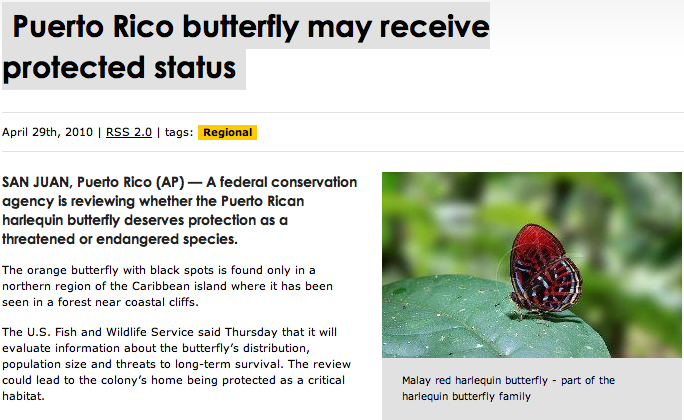
Chris Grinter, on June 23rd, 2010 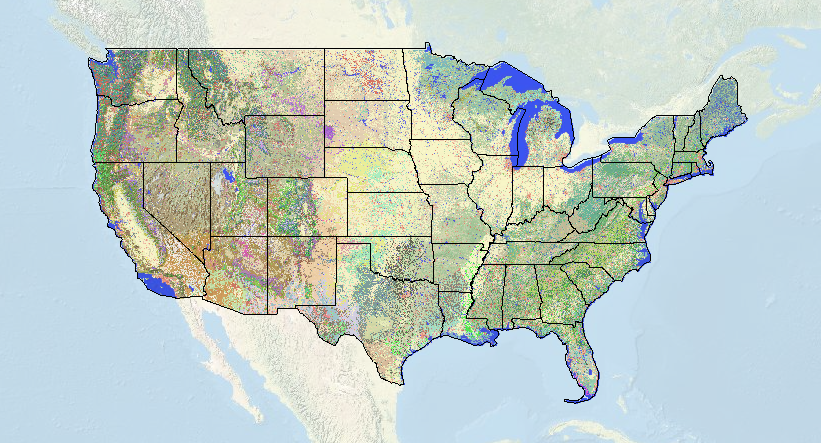
I’ve always wondered how to find the correct terminology for land cover in a given area. Usually, I just ballpark something along the lines of “oak chaparral”. But now I can use this awesome new map brought to us by the USGS/National Biological Information Infrastructure. The level of detail is amazing, and you can specify the degree of accuracy with a drop down tab (1-3). Now with a high-def US topo map I can see exactly where the largest stands of monterrey pine are (actually it’s a California Coastal Closed-Cone Conifer Forest and Woodland) so I can optimally place my trap this weekend.
Continue reading Landscape Cover Map
Chris Grinter, 18. lipnja, 2010 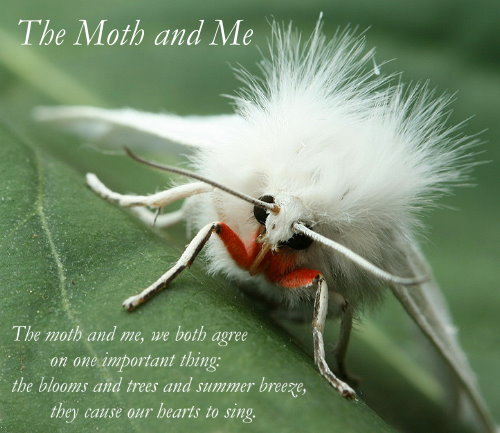
Dobrodošli na moljac i meni #12, i moj prvi blog karneval. Unatoč bloganje za nekoliko mjeseci imam još pogledati unatrag i razmišljati o tome kako je točno da su se zaljubili u leptira na prvom mjestu. Sjećanje na vrijeme ili mjesto gdje se to dogodilo je nemoguće, and like many of my colleagues and I’m sure many of my readers, I had a butterfly net and “bug cage” in hand as soon as I could walk. When it comes to entomology I believe almost everyone falls in love at first with a large and striking insect. For me it was a butterfly, naturally. I can remember staring for endless hours at the diversity of Ornithoptera and Papilio illustrated in Paul Smart’s famous book. Somewhere along the way in pursuit of something new I began to stray into the nocturnal world. Moths comprise the majority of the diversity of Lepidoptera; while there are nearly 11,000 species in the United States, only a few hundred are butterflies. This quickly opened a door (maybe into an abyss…) to the shocking abundance found everywhere around us. This amazing diversity has now drawn me deep into the biology and evolutionary history of the Lepidoptera. Editing these fourteen contributions of moth blogging together I just can’t help but to reflect back on some of my own mothing journey.

Perhaps if I was a child in Europe this moth (Deilephila elpenor porcellus) would have been the first to catch my eye. Over at Urban Moths Ron Laughton has discovered the stunning diversity in his own back yard in much the same way as I did growing up here in the US. Take a look at the types of traps he has been using, most of which he constructed himself. One of the best behaviors of moths is their willingness to dive headlong into the light. Not too far from Ron, Mike Beale has been blogging british moths as well. It can be pretty amazing just how similar our two faunas are (a few moths actually are the same).
Continue reading The Moth and Me #12
Chris Grinter, 11. lipnja, 2010 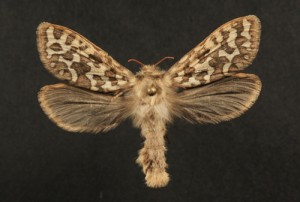
Ovaj moljac je jednako rijedak kao i njegov paranormalni imenjak (osim što je stvaran) – to je Gazoryctra sp. u obitelji Hepialidae. Predstavljaju bazalnu lozu Lepidoptera i obično su poznati kao moljci duhovi ili brzi moljci. Duh – jer je poznato da mužjaci nekih vrsta lete u pravim lekovima, gdje lebde gore-dolje na travnatim čistinama u sumrak dok ženke promatraju. Ti isti mužjaci također traže ženke s feromonima, malo zaostala situacija s kukcima. Brz- već samo po sebi razumljivo, ali poznato je da su borealne vrste moćni letači.
Jedna od značajki koje pomažu ukazati na to kao na bazalnu lozu je postavljanje krila na tijelu, neka venacija krila, smanjen ili odsutan usnik i nedostatak jakog uređaja za spajanje krila. Ovi moljci imaju a “jaram”, što je mala izbočina nalik palcu s vrha stražnjeg krila. Druge loze moljaca imaju čvrsti mehanizam spajanja poznat kao frenulum i retinakulum, gdje čekinje spajaju dva krila tako da ostaju spojena tijekom leta. Kada miruje, jugum se savija i vjerojatno pomaže u održavanju krila zajedno – ali ne dok je u letu; prednje krilo nije sinkronizirano sa stražnjim krilom i let nije dinamičan (Scoble 1992).
U Americi je biologija hepialida vrlo slabo shvaćena. Na globalnoj razini opisano je samo nekoliko životnih povijesti – sve od kojih se čini da su endofagi (dosadno) u korijenskim sustavima biljaka. Neke ličinke u ranom stadiju mogu se hraniti u leglu lišća ili ispod zemlje u korijenskom sustavu prije nego uđu u rizom. Australija ima sreću da ima raznoliku i impresivnu faunu Hepialidae – mnogi jesu sjajno obojena i ogroman (250mm ili do 12 inča!), i malo bolje proučena. Neke su ličinke čak dovoljno česte da su ih aboridžinska plemena koristila kao glavni izvor hrane.
No, vratimo se posebno ovom moljcu. Sakupio sam ga u svojoj zamci crnog svjetla prošlog kolovoza u Sierra Nevadi 10,500 stopala. Vrsta je nepoznata, i vjerojatno je nova. Najviše frustrirajuće je to što je to jedini primjerak poznat znanosti. Cijeli rod je vrlo rijedak, osim jedne ili dvije obične vrste, postoji samo nekoliko desetaka primjeraka. Pa je li to ženka vrste opisane samo od mužjaka? Čudna aberacija inače poznate vrste? Ili je možda zapravo nov. Ja sam barkodirao DNK, to mi zapravo ništa ne govori budući da nema sekvenci iz bilo koje blisko srodne vrste. Zapravo, koliko ja znam, druge vrste u Sierri nisu čak ni skupljene desetljećima pa ne mogu dobiti ni sekvencu od starijeg primjerka. Šlag na torti je njihovo ponašanje. Oni rijetko, Ako ikad, izaći na vidjelo – što može biti posljedica njihova krepuskularnog leta. U pravoj noći mogu biti na krilu za 20-30 minutama, obično ženka traži mužjaka, ili ženka koja leti do jajnih stanica (vjerojatno samo emitiraju razbacuju svoja jaja po tlu). Dakle, dođite ovog kasnog kolovoza, vratit ću se u visoku Sierru s nekoliko volontera s odjela za entomologiju u nadi da ću vidjeti jednog kako fijuče pored mene na strmim padinama. Ako dobijem još, moglo bi se pokazati kao impresivna nova vrsta za Kaliforniju.
Chris Grinter, 11. lipnja, 2010 Who can see what’s wrong with this article?

Chris Grinter, on June 9th, 2010 
Ovaj recent article in the American Naturalist has taken a second look at some of the famously inflated species estimates, some going high as 100 million (Erwin, 1988). Estimates conducted by the authors indicate that projections above 30 million have probabilities of <0.00001. Their estimated range is more likely to be between 2.5 i 3.7 million species (s 90% confidence). This seems somewhat reasonable given that these extraordinary estimates were based heavily on extrapolation. There are clearly many difficulties in assessing diversity based on tropical arthropod surveys – this paper again uses phytophagous (plant-eating) beetles for estimates. They are careful to point out that these methods do not account for non-phytophagous insects, but assume that they will follow traditional biogeographic patterns of diversity. This is somewhat of a new concept given that when I was in college I was taught that parasitoids are counterintuitively not more diverse in tropical regions. This hypothesis is more often than not being proven false in the light of more precise modern taxonomic methodology. Rather proudly I helped play a role with the parasitoid project at the UIUC. Ukratko, host specificity is more extreme in tropical environments with hundreds of cryptic species hidden amongst rapidly radiating groups such as the microgastrine Braconids (Hymenoptera) – the same has held true across similar taxa.
One interesting note about the paper is their inclusion of a secondary estimation based on Lepidoptera canopy assemblages. They assumed that a) all Lepidoptera can be found in the canopy and b) that all leps are phytophagous. This is clearly a very conservative estimation given that not all Lepidoptera are found in the canopy and not all are phytophagous. While I do not have the numbers on hand, a certain percentage of lep diversity must have been excluded from these estimates. I will also go out on a limb and assume that the authors (Novotny 2002) did not include microlepidoptera morphospecies – and most likely estimated abundances with our current taxonomic understanding. However I do not have access to this 2002 paper, so I may be incorrect. Using these Lepidoptera numbers (from the same survey as the Coleoptera) a global diversity was estimated by Hamilton et. al. at around 8.5 millions arthropod species.
While I agree that extraordinary estimates of tens of tens (or hundreds) of millions of arthropod species are probably ridiculous; I am of the camp that current research is indicating that estimates of the lower tens of millions of species are possible. The authors have failed to include research that counterbalances their premise that tropical species exhibit a lower beta diversity (Novotny 2002, 2007). In the same journal, Nature 2007, Dyar et. al. have indicated that the American tropics exhibit a higher beta diversity than previously assumed. Either it can be said that estimates of beta diversity in the australasian tropics are incorrect, or they are incompatible with species assemblages of neotropical forests. All of this speaks to the difficulty in extrapolating estimations of species across all tropical regions. These estimates are based on comprehensive insect surveys of New Guinea, perhaps they do not accurately reflect the true diversity of American tropical forests, and these number ranges are low.
As a final thought, most assesments are focused on tropical arthropods. It seems all too possible that the total number of all species, including bacteria and archaea, can easily exceed tens of millions. But extrapolating those numbers is even more precarious than arthropods, given the extreme lack of knowledge we have.
Chris Grinter, 4. lipnja, 2010 
Ne mogu pronaći način povezivanja izravnog videozapisa (čak ni VodPod), but here is the link to the Daily Show site. Koliko je fizičara čupalo kosu kad su čuli ovo? jao, on je novoimenovani glasnogovornik. Don’t worry Neil, ne ideš nikamo nakon ovoga.
Having not aired yet I can’t tell exactly how apologetic the show je, but it seems heavily focused on finding the “creator”. I can hear it in John Stewart’s voice when he pulls back from ripping into Freeman’s “god of the gaps” theory. Perhaps there was an edit and we missed the question where John Stewart asked “Morgan, can you define a logical fallacy for us… perhaps the god of the gaps one?” I believe that any physicist who ever says “god was responsible” says it with no deeper meaning than when Einstein famously evoked god’s dice. That’s to say, a non-literal and non-personal god found only in the beauty and splendor of nature.
Chris Grinter, 2. lipnja, 2010 
Ako postoji jedna stvar koju sam naučio na faksu, bilo je kako se lako sebe odvratiti. I imaju tendenciju da zadrži svoj TV u pozadini, dok sam radio na mom računalu, osobito kasno noću, kada sam obično borim pobjednički rat protiv sna. Neku noć mi je nešto zapelo za oko: čovjek koji drži radiestezijske štapove u svom dvorištu. Pojačati, neka teku sranja. Bio je to samo bljesak idiotizma u inače dobrom programu o poboljšanju doma. Navikao sam se na TV baziranu na sranju na mrežama kao što su History Channel ili Discovery mreža (kvaliteta njihovih emisija uključuje dragulje poput “Ukleti: duhovi i kućni ljubimci”), ali bio sam malo iznenađen kad sam vidio da BS krasi moju lokalnu PBS postaju.
Preko na “American Woodshop” domaćin Scott Phillips gradio je prekrasnu vrtnu sjenicu. Ovdje možete pogledati cijelu stvar besplatno: Epizoda 1609: Arhitektonske letvice i obloge iz razdoblja. Na isječku nema vremenskih oznaka, ali radiestezija dolazi oko sredine. Dok je demonstrirao materijale potrebne za pričvršćivanje drva za tlo, upozorio je da ne nasumično kopate u svoje dvorište ne znajući gdje je podzemna voda, električni ili plinski vodovi bili su: solidan savjet. Dakle, da biste to učinili, trebali biste (parafrazirano) “uzeti komade vješalice, sve će poslužiti, pretvoriti ih u “L”. Dok hodam naprijed, rešetke se križaju – tamo (prelaze) – tamo je linija za navodnjavanje. 9 od 10 ljudi imaju tu sposobnost, ali trebali biste pozvati stručnjaka ako postoji bilo kakva sumnja“. Moj prijevod “OK dečki, ne brinite o tome da pozovete nekog tipa da to učini, shvati to na ovaj način”. Molim te, reci mi koji bi čovjek koji ozbiljno gleda emisiju o poboljšanju doma u ponoć prepustio ovlasti nekome drugom prije nego što mu da dobro staro’ pokušati na fakultetu? Čak i ako to na trenutak priznamo 9 od 10 ljudi bi mogli ovo učiniti, što je s tim jednim tipom koji ne može? Nije li neodgovorno sugerirati da možete izbjegavati samo struju/vodu/kanalizaciju/plin 90% od vremena? ups, udari u onaj dosadni plinovod…
Biti znanstvenik, skeptik i prokrastinator – Napisao sam Scottu poruku o ovome kako bih mogao izbjeći svoj posao. Danas je ljubazno odgovorio rekavši: (izvod)
“Naša su tijela elektromagnetska polja. Poremeti polje i stvari se dogode…. Naučio sam spomenutu tehniku od gradskog radnika koju su koristili za pronalaženje linija. Ne od šarlatana. Moj tim svjedočio je objektivnoj uporabi ove tehnike.”
Kratko, Ne, naša tijela nisu elektromagneti. Svatko može držati kompas, ili TV… a da ih ne zeznete. Franz Mesmer skovao je ideju o “Životinjski magnetizam” u drugoj polovici 18. stoljeća (također izmišljen “hipnotiziranje” AKA hipnoza) – a naglo su ga razotkrili Benjamin Franklin i drugi. Također sam pomalo zabrinut kad čujem da se gradski radnici oslanjaju na radiesteziju kako bi locirali javne vodove! Ali da krenem dalje, istražimo mitove o radiesteziji. Slažem se da se čini da postoji donekle intuitivna istina kada je u pitanju radiestezija, koliko god to znanstveno bilo lažno, ostaje uvjerljivo. Svakako… električne stvari underground efekt osjetljive žice iznad. I vau, pogledaj sve te tipove koji mogu pronaći vodu, ili moć, ili… izgubljeni ljudi… ili bombe? u redu, držimo se vode za ovaj razgovor.
(nastavio)
Continue reading An Uphill Battle
Chris Grinter, 1. lipnja, 2010 Just a few images of common California leps, taken along the coast range near Santa Cruz a few weeks ago. Starting to work my way through some photo backlog…

Plebejus acmon
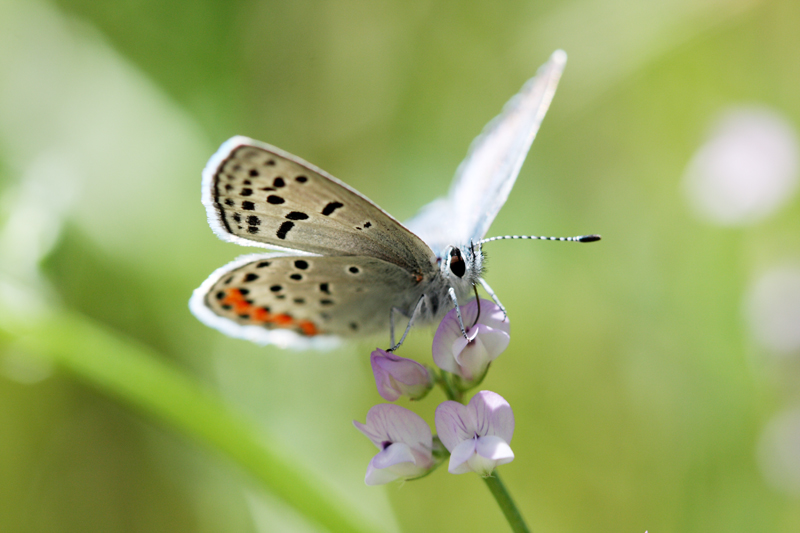
Plebejus acmon
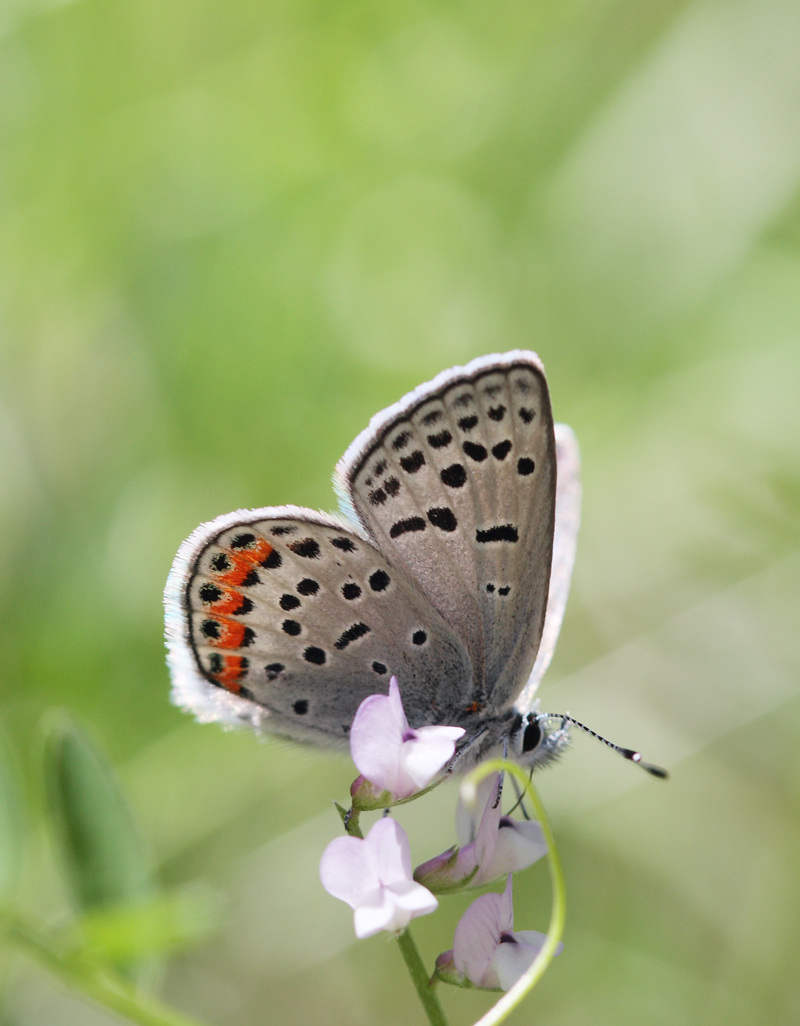
Plebejus acmon

Ethmia arctostaphylella on Eriodictyon sp.
One interesting note on Ethmia arctostaphylella – the name is a misnomer, it does not actually feed on Arctostaphylos (Manzanita). At the time of description in 1880 Walsingham had found larvae pupating on leaves of manzinata and assumed it was their host plant. In Jerry Powell’s stunning monograph of the group he indicates this moth was reared from Eriodictyon – which happens to be the flower the moth is perched on. The two plants grow side by side, and it’s pretty easy to see how a wandering caterpillar finds its way onto a neighbor.
|
Skepticizam
|













